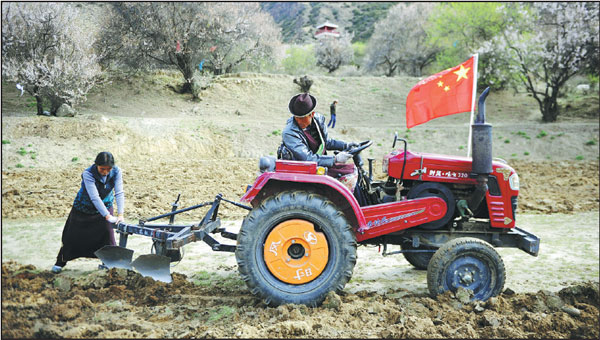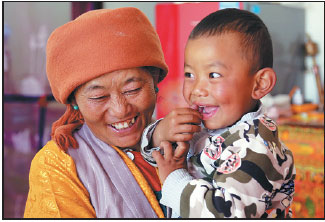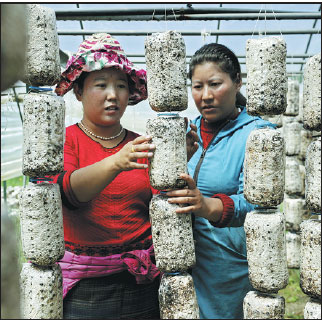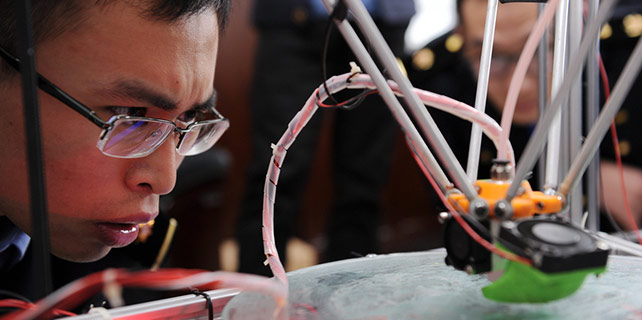Bringing new hope to poorest people on plateau
Editor's note: This is the second of a series of special reports China Daily is publishing on efforts to eradicate poverty and raise living standards in rural areas, especially among the nation's ethnic groups.
Sonam Tenzin has a clear understanding of what modern material wealth would mean to him: treatment and medication for his elderly, disabled mother, and his aunt and uncle; money to pay his mortgage; and a decent education for his two sons.
However, Sonam lives in Nyingchi, a prefecture-level city in the poverty-stricken area around the Yarlung Zangbo River basin, where making a living has never been easy.
Most residents of this impoverished area in the southeast of the Tibet autonomous region live on the meager crops they grow on the sparse farmland and earnings from selling matsutake mushrooms they pick in nearby forests.
The 27-year-old Tibetan is separated from his wife, so he single-handedly supports his sons and his three aging relatives.
"We are just getting by. After all, I have to manage all the financial ins and outs myself," he said.
Last year, the family's situation went from bad to worse when their house was severely damaged by fire. Despite help from a support fund established by the regional government, Sonam had to take out a bank loan of 60,000 yuan ($8,690) to repair the building.
Authorities estimate that 590,000 people - about 20 percent of Tibet's population - still live below the government's designated annual poverty threshold of 2,300 yuan in disposable income.
Like Sonam Tenzin, most of those badly affected by poverty live in the region's margins, challenged by the harsh natural environment and an underdeveloped transportation infrastructure that makes traveling difficult.
Nyima, deputy head of the Nyingchi office for poverty alleviation, said isolation is one of the main problems for the region's poorest inhabitants.
"Some people live on high mountains and others in deep valleys that are too harsh to provide a decent life. Many have long been troubled by illness or disability," he said, adding that much of the remaining poverty in Nyingchi, which has a population of about 250,000, centers on households that lack able-bodied workers.
However, there are many cases in which villagers don't try hard enough to change their lives, according to Nyima, who like many Tibetans uses just one name.
"We have been trying to set a good example and introduce them to good programs, but those with the initiative to improve their own lives have probably already done so," he said.
Development goals
The regional government has set the goal of eradicating poverty by 2020. During the next five years, it plans to invest 18 billion yuan ($2.5 billion) in 1,216 development programs, most of which are designed to provide employment opportunities for the less well-off or help them to establish cooperatives.
Meanwhile, the authorities will move about 236,000 impoverished people into resettlement projects, and a loan of more than 38 billion yuan has been obtained to finance the process.
The new dwellings have been well-received by many villagers. In Lhasa's Quxu county, the local authorities have relocated 172 households to Sanyou village, where they live in newly built two-story houses that were fully furnished long before the occupants arrived.
Dashon, a 52-year-old resident, said that in the past she and her family had to shelter in a neighbor's house whenever it rained.
"Our house could have collapsed at any minute, and we often feared for our safety," she said.
Sonam Dekyi, a government official in Sanyou, said villagers vote to determine which families will be allowed to move into the new settlement.
"We constantly remind them that moving here is the start of their new lives. They should not be satisfied with the status quo," she said.
In the coming five years, the regional authorities will also provide part-time jobs, such as forest ranger posts, for 500,000 people.
Lu Huadong, deputy head of the Tibet poverty alleviation office, said the government has now entered the personal details of 590,000 officially designated poverty-stricken people in its archives.
"We have identified 11 different factors that help to explain why these people live in poverty, and different measures will be adopted for different people and different households to help lift them out of poverty," he said.
Penpa, a 48-year-old resident of Bayi township in Nyingchi, described himself as being "weak as a hen" after a long-term stomach ailment. He spends about 10,000 yuan on medical bills every year, and has a 70,000 yuan mortgage after building a new house in 2014 to replace the wood cabin he shared with his wife.
However, because he chose private clinics over public hospitals he has waived his right to claim medical insurance.
With the help of the authorities, Penpa and eight other villagers set up a cooperative to raise Tibetan chickens.
"We're desperately poor, but I definitely don't want to stay this way," he said.

Meanwhile, in Sonam Tenzin's village, the local authorities have helped 11 poverty-stricken households to establish a cooperative to raise pigs.
He said he could have made a much larger income if he had migrated to an urban area in search of employment opportunities. "But I have people to take care of. What if they got sick while I was absent?" he said.
Instead, he has been offered a job as a forest ranger, which will guarantee an annual income of about 3,000 yuan. He also has an occasional part-time job as a taxi driver for tourists bound for the Yarlung Zangbo River.
However, Sonam Tenzin said he still fears the worse-case scenario: That a relative will be hit by a serious illness and the medical bills will be beyond his means.
"I don't think anyone would lend me any money. It would be natural for them to doubt my ability to repay them," he said.
Challenges and concerns
The real challenge for the authorities in their poverty-alleviation efforts lies in working out how poor households can be helped to make a living without government assistance.
Nyima, the official, voiced concerns about the potential side effects of providing poverty-stricken families with free resettlement.
"The government definitely has good intentions. Despite that, people who have managed to break out of poverty through their own efforts might think that some others did nothing but still managed to move into spacious new homes and will simply accept another subsidy at the end of the year," he said.
"Some people just do nothing and think the government will take care of them, anyway," he added. "Stopping the resettlement projects from turning into slums is at the top of our agenda."
In one resettlement project in an urban area of Nyingchi, the authorities have set an entry condition that requires poor households to have at least one person working in the area before they are allowed to move in. Migrants are also allowed to keep the farmland they have left behind.
Despite his excellent academic performance, the need to support his family forced Sonam Tenzin to drop out before he finished high school. Now, his dearest wish is that his children will receive an education good enough to help them live up to their potential.
"Every time I am invited to a gathering of my junior high school classmates, I always refuse. We were very close, but now we live very different lives," he said.
"I just hope my children will not be in the same position as me in the future."
Contact the writers through xuwei@chinadaily.com.cn
|
Farmers plow before sowing their crops near a wild peach wood in Nyingchi, a prefecture-level city in the Tibet autonomous region, in April. Every spring, thousands of tourists descend on the city to view the blossoms, providing job opportunities for local residents.Zhang Rufeng / Xinhua |
|
Dashon hugs her grandson at her new house in Sanyou village near Lhasa.Daqiong / China Daily |
|
Phurbu Chozin (left), founder of an agricultural cooperative in Nyingchi, teaches a villager how to grow mushrooms.Zhang Rufeng / Xinhua |
(China Daily USA 11/29/2016 page1)















